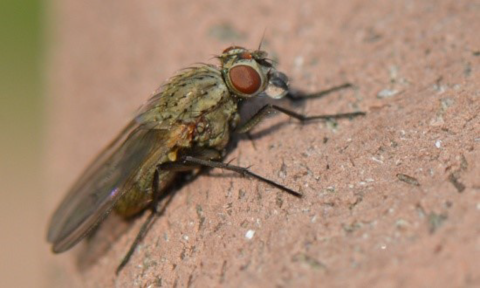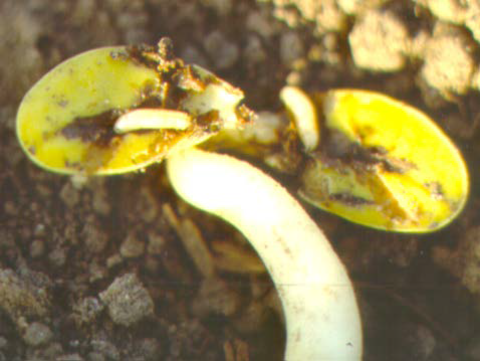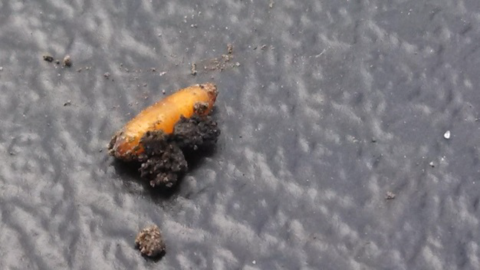The seedcorn maggot – Deltia platura (Meigan), Diptera: Anthomiidae – is the larva of a fly. The gray adult is less than 1/4 inch in length and resembles a small slender housefly (Figure 1).
The small, headless, larvae are less than one-fourth of an inch long, and white to light yellow in color. The body is tapered toward the head end. There are no visible legs or head capsule (Figure 2).
The pupae are oval and orange (Figure 3). As they age, the pupae turn dark brown. Only the adult stage occurs aboveground.
Where they live
This insect occurs worldwide.
Hosts
The seedcorn maggot has a wide host range. The related cabbage maggot Deltia radicum L. is limited to cruciferous crops.
In addition to feeding on decaying organic matter, the seedcorn maggot attacks the germinating seeds of corn, soybean, edible bean, melons and other large seeded crops belowground.
Onions, canola and many other diverse crops are also hosts.
Life cycle
In Minnesota, the seedcorn maggot overwinters as a pupa in the soil. There are at least two generations in Minnesota.
Pupa development occurs when spring soil temperatures are warmer than 3.9 degrees Celsius (39 degrees F). Adults emerge in late April to May.
Degree days
You can use degree-day (DD) development models to predict the timing of fly activity. Fifty percent of the overwintering generation emerges as adults when 206 DD (3.9 degrees Celsius base) / 371 DD (39 degrees Fahrenheit base) have accumulated using 2-inch soil temperatures.
Adults are attracted to newly tilled fields and decaying organic matter. Eggs are laid in moist soil.
Fields at highest risk of damage are those with heavy applications of solid livestock manure and where a green manure (including heavy weed infestations and live cover crops) has been incorporated.
Natural enemies
Natural enemies of the seed corn maggot include:
Ground beetles.
Predaceous nematodes.
Fungal diseases.
You’ve probably seen small flies that have died on tall plant foliage. These are often seedcorn maggot adults that have been killed by a fungus.
Damage
Damage from this insect is often worse when crop emergence is slow.
Feeding injury results in seedling injury and stand loss. Corn seed and seedlings can be heavily infested, reducing the stand. However, field corn stand losses can be lower than in other crops.
This is because of the seedling’s structure and because corn is often planted before flies are active.
The maggots have weak, hook-like mouthparts and can attack corn seeds only after they’ve been softened by water uptake. In corn, the endosperm is usually attacked and some tunneling in belowground tissues may occur.
The maggots damage germinating soybean and other large-seeded dicots by tunneling into cotyledons and hypocotyls (Figure 4). When a soybean’s plumule is damaged, the plant may form two terminal shoots or “snake heads.”
Scouting
In high-value crops and higher risk situations, yellow sticky traps or cone traps baited with molasses can help to determine whether adults are present after tillage and before planting.
When scouting corn, look for missing and stunted plants. In soybean, look for thin stands and plants with missing, scarred and malformed scarred cotyledons.
Seed corn maggots have very quick life cycles and a new generation of adults can appear in three to four weeks. Often, only the dark oval pupae, empty pupal cases or distinctive feeding damage are found by the time stand loss is detected.
Managing infestations
There are no rescue treatments for seedcorn maggot infestations. Where possible, avoid planting higher risk fields during peak adult activity.
In addition to predicting when egg-laying flies are active, degree-day models can be helpful in predicting when the damaging life stages are no longer active. By waiting 2.5 or more weeks (250 DD; 3.9 degree C base) after incorporation of organic material, seedcorn maggot would be in the non-damaging pupal stage.
While seedcorn maggot can be devastating to stands of corn, soybean and other crops, economic infestations are very sporadic and fairly predictable. For this reason, insurance insecticides aren’t recommended.
For high-risk situations, neonicotinoid insecticide seed treatments and at-plant corn rootworm insecticides provide good control. These insecticides can, however, be overwhelmed by very high seedcorn maggot populations.
Always read and follow the pesticide label.
Broatch, J.S., Dosdall, L.M., Clayton, G.W., Harker, K.N., & Yang RongCai. (2006). Using degree-day and logistic models to predict emergence patterns and seasonal flights of the cabbage maggot and seed corn maggot (Diptera: Anthomyiidae) in canola. Environmental Entomology, 35(5), 1166-1177.
Funderburk, J.E., Higley, L.G., & Pedigo, L.P. (1984). Seedcorn maggot (Diptera: Anthomyiidae) phenology in central Iowa and examination of a thermal-unit system to predict development under field conditions. Environmental Entomology, 13(1), 105-109.
Funderburk, J.E., & Pedigo, L.P. (1983). Effects of actual and simulated seedcorn maggot (Diptera: Anthomyiidae) damage on soybean growth and yield. Environmental Entomology, 12(2): 323-330.
Funderburk, J.E., Pedigo, L.P., & Berry, E.C. (1983). Seedcorn maggot (Diptera: Anthomyiidae) emergence in conventional and reduced-tillage soybean systems in Iowa. Journal of Economic Entomology, 76(1), 131-134.
Hammond, R.B. (1995). Timing of plowing and planting: effects on seedcorn maggot populations in soybean. Crop Protection, 14(6), 471-477.
Hammond, R.B. (1997). Long-term conservation tillage studies: impact of no-till on seedcorn maggot (Diptera: Anthomyiidae). Crop Protection, 16(3), 221-225.
Hammond, R.B. & Cooper, R.L. (1993). Interaction of planting times following the incorporation of a living, green cover crop and control measures on seedcorn maggot populations in soybean. Crop Protection, 12(7), 539-543.
Higley, L.G. & Pedigo, L.P. (1984). Seedcorn maggot (Diptera: Anthomyiidae) population biology and aestivation in central Iowa. Environmental Entomology, 13(5), 1436-1442.
Higley, L.G., & Pedigo, L.P. (1985). Examination of some adult sampling techniques for the seedcorn maggot. Journal of Agricultural Entomology, 2(1), 52-60.
Hough-Goldstein, J.A. (1985). Oviposition site selection by seedcorn maggot flies (Diptera: Anthomyiidae) unaffected by prior experience or larval host. Environmental Entomology, 14(3): 289-292.
Hough-Goldstein, J.A., & Hess, K.A. (1984). Seedcorn maggot (Diptera: Anthomyiidae) infestation levels and effects on five crops. Environmental Entomology, 13(4), 962-965.
Koch, R.L., Rich, W.A., Potter, B.D., & Hammond, R.B. (2016). Effects on soybean of prophylactic in-furrow application of insecticide and fertilizer in Minnesota and Ohio (Plant Health Progress no. March: PHP-RS-16-0006).
Krupke, C.H., Alford, A.M., Cullen, E.M., Hodgson, E.W., Knodel, J.J., McCornack, B., Potter, B.D., Spigler, M.I., Tilmon, K., & Welch, K. (2017). Assessing the value and pest management window provided by neonicotinoid seed treatments for management of soybean aphid (Aphis glycines Matsumura) in the Upper Midwestern United States. Pest Management Science. http://doi.org/10.1002/ps.4602.
Kuhar, T.P., Hutchison, W.D., Whalen, J., Riley, D.G., Meneley, J.C., Doughty, H.B., Burkness, E.C., & Wold-Burkness, S.J. (2006). Field evaluation of a novel lure for trapping seedcorn maggot adults. Plant Health Progress (no. June: 1-3.)
Photos
All photos were taken by Bruce Potter, unless otherwise noted.
Reviewed in 2018





